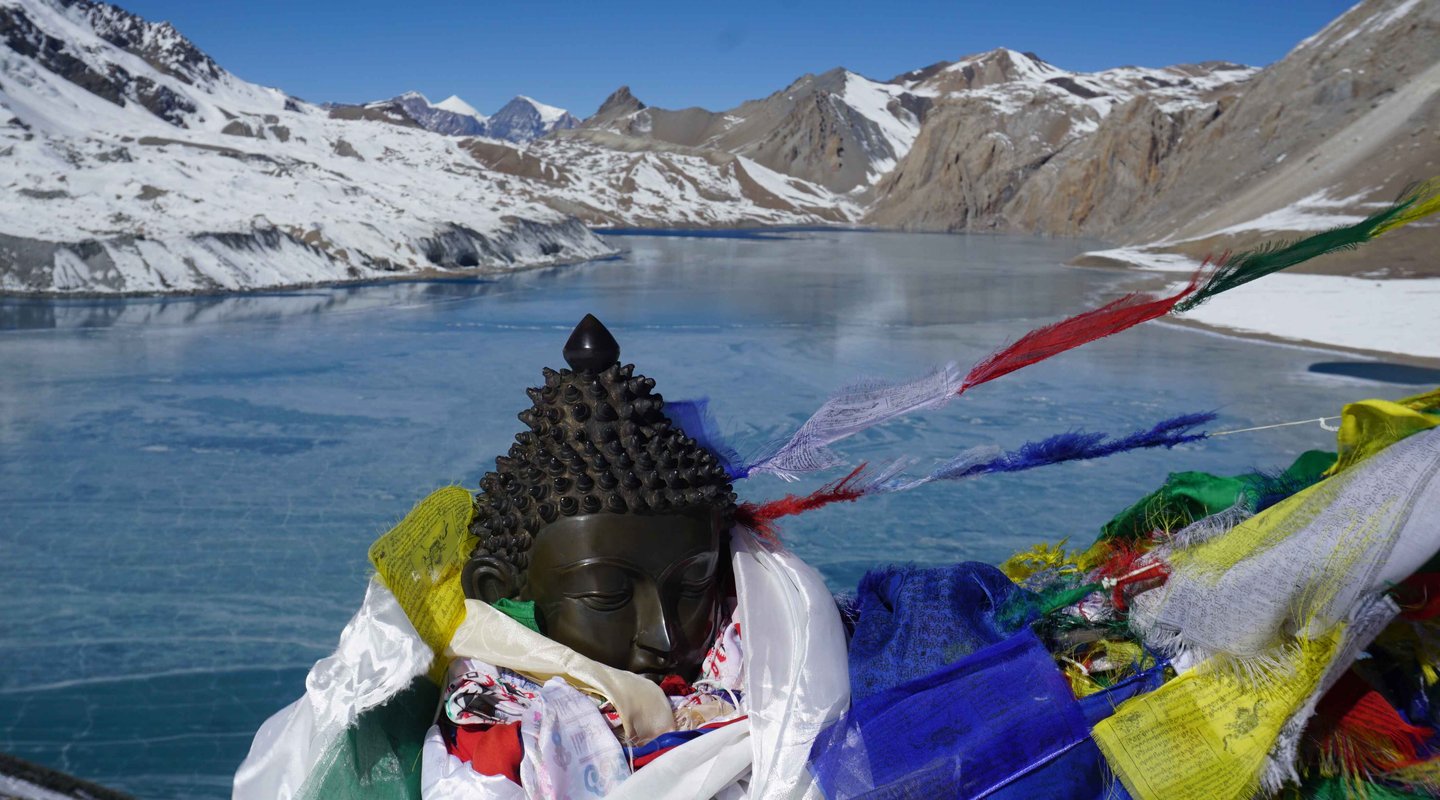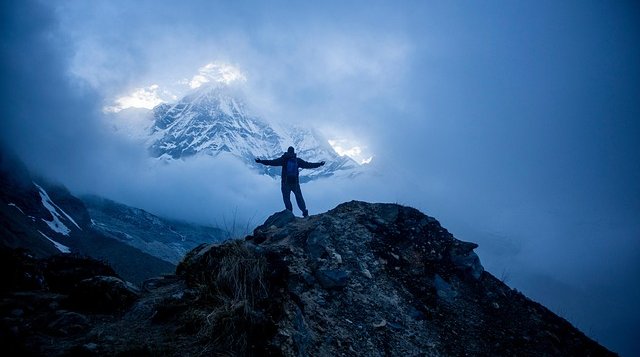Introduction
Wondering if you can do the Annapurna Circuit Trek in a short timeframe and take full enjoyment as much as the full Annapurna Circuit Trek? Yes, you can. Our experts have designed a short Annapurna Circuit Trek for people like you. We can help you clear your doubts and concerns through this guide.
A majestic journey to the highest lake in Nepal, Kajin Sara Lake (5,202 meters altitude), to the highest pass in Nepal, Thorong La Pass (5,416 m/ 17,769 ft) and one of the highest temples in Nepal, Muktinath, this trekking route has become one of the hyped trekking destinations and gets in the bucket list among the foreigners too.
You can do a short Annapurna Circuit Trek of either 6 days or 8 days depending on your choice and it is appealing because of the proper availability of the tea houses, and guides and porters navigating through the diverse topography, stunning mountain scenery of Mt. Annapurna range and the rich tapestry of the indigenous Gurung and Thakali communities, which gives you the most adventurous feeling when you cross Thorong La Pass (5,416 m/ 17,769 ft) and cultural, and spiritual trekking experiences with the monasteries and temples such as Muktinath pilgrimage site (3,760 m/ 12,623 ft). Through this article guide, we will guide you on how you can make the most of your short Annapurna Circuit Trek.
Why choose a short Annapurna Circuit trek?
Short Annapurna Circuit Trek is an ideal plan for people who have no trekking experience, who have tight schedules, and who are considering it as a family trip. This Annapurna Circuit shorter duration plan caters to different needs, including the fitness and endurance levels of the individuals, making it one of Nepal’s Best short treks.
Time Efficiency: If you have a busy schedule but you still want to immerse yourself in the rich natural and cultural heritage of the Annapurna Circuit, then a short Annapurna Circuit Trek is the perfect solution. You can still enjoy the magnificent views and get a cultural immersion by engaging in the local culture if you have a tight itinerary plan. You can make your adventurous trek of the Annapurna Circuit a shorter duration as well.
Accessibility: You can start from the key access points such as Chame and Manang. You can take a bus or a Jeep to reach these points, and if you start your trek from Chame, then you can skip the lower sections and crowded sections, taking a straight leap to the stunning views of the mountains of Annapurna II and Annapurna IV. So, if you are doing a short Annapurna Circuit Trek, then it gives you more acclimatization time and enjoy the ecosystem and local culture by reaching in a shorter time.
Focused Experience: You can focus on the iconic points of the region, such as enjoying the picturesque Manang valley, renowned for its majestic mountain scenery, terraced fields, lush valleys, and engaging in the local festivals at the temples and monasteries, because of the short Annapurna Circuit Trek.
Understanding the Different "Short" Annapurna Circuit Options (The Core Comparison)
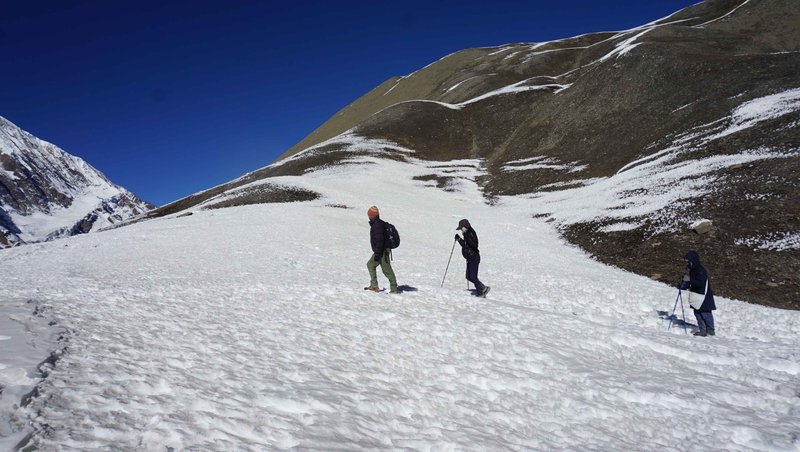
The 6-Day Power Trek
The 6-day short Annapurna Circuit Trek will begin from Kathmandu. You will take the Kathmandu to Chame drive, and this ride will be for around 8 to 9 hours. Chame will be your starting point for the trek. You will pass through the dense forests, picturesque villages, and feel the warm hospitality of the locals. You will cross Thorong La Pass (5,416 m/ 17,769 ft), and this Thorong La Pass trek is the climax of this powerful trek. You will witness the panoramic views of the Annapurna range and the connection of spirituality with the numerous flags around, including the diverse flora and fauna. After that, you will make your descent to Jomsom and then take a drive to Pokhara.
Pros: The 6-Day short Annapurna Circuit Trek is the fastest planned trek. You can witness the iconic mountain views and cultural heritage within such a short period. This will allow you to hit key high-altitude points such as which provides you the feeling of accomplishment. This short trek will allow you a brief cultural immersion into the local culture and traditions.
Cons: As this 6-Day short Annapurna Circuit Trek pushes you to complete the trek within a very short time, this very rapid ascent increases the risk of you getting altitude sickness. So, you will get less acclimatization time. Especially if you have no prior experience with high-altitude trekking in Nepal, this power trek will be exhausting for you.
Ideal for: This exhilarating 6-Day short Annapurna Circuit Trek is ideal for those who are highly fit and who love the thrill of adventure, as it has to be done in the rugged terrains within a short time frame. This power trek will be especially loved by you if you are an experienced trekker with excellent acclimatization abilities.
The 8-Day Balanced Journey
The 8-Day short Annapurna Circuit Trek is significantly shorter than the full Annapurna Circuit. Your trekking journey will begin from Kathmandu or Pokhara, taking you to Chame. And Kathmandu to Chame is a long drive of 8 to 9 hours through Besisahar. You will start your trek from Chame, passing through the lush forests, terraced fields, and picturesque villages. You will get into the local culture of Tibetan Buddhist villages with a mild level of acclimatization.
And then you will continue your trek to the highest pass, Thorong La Pass (5,416 m/ 17,769 ft), showcasing stunning views of the mountains. This trek will provide you with one day of acclimatization in Manang, giving you the time to adapt to the rapid change in altitudes to prevent Altitude sickness. Then you will move ahead by descending towards one of the holiest places in Nepal, the Muktinath pilgrimage site (3,760 m/ 12,623 ft), where you will feel the strong religious and spiritual connection of the Annapurna region with its natural beauty, including diverse flora and fauna. After this, you will head towards your ending destination, Pokhara, through Jomsom.
Pros: The 8-Day short Annapurna Circuit Trek is designed to provide you with a good experience of the blend of adventure and cultural richness without committing to a longer itinerary plan. This is a better-balanced journey, providing you with an acclimatization at Manang. One of the key stops will be Muktinath, where you will get to witness the magical blend of Buddhism and Hinduism.
Cons: Although the 8-Day short Annapurna Circuit Trek is a shorter version of the full trek, you still require a good level of physical fitness as you will navigate through some challenging terrains, including the Thorong La Pass trek. So, it is great if you have some physical training routines before the trek, and you need to learn the strategies to avoid altitude sickness and tackle harsh weather conditions. Moreover, you will have less time to rest, so you need to be mindful of your physical limits.
Ideal for: The 8-Day short Annapurna Circuit Trek is an ideal itinerary plan for those who have a moderate level of fitness but also want to take full enjoyment without much strain within the Annapurna Circuit's shorter duration. So, this is a balanced journey of adventure with some challenges without being overly demanding of your physical fitness.
The 10-Day Comprehensive Short Trek

The 10-Day short Annapurna Circuit Trek will begin at Besisahar, where you will reach through a long drive from Kathmandu. You will trek along the Marshyangdi River before reaching Chame. When you reach Manang, you will acclimatize there before embarking on the most challenging part, which is crossing the Thorong La Pass trek. You will get to experience the change in the terrain from lush subtropical forests to alpine meadows as altitude increases. After crossing the pass, you will descend towards Muktinath and reach Tatopani, which offers natural hot springs, a popular place for relaxation after the daunting trek passing through Jomsom. And, finally, you will move ahead towards Pokhara, where your 10-Day short Annapurna Circuit Trek ends.
Pros: The 10-Day short Annapurna Circuit Trek will cover almost all the key locations of the Annapurna Circuit, offering you the closest in feel to the original circuit as you would feel in the longer treks. You will get to enjoy the lower elevation trekking with vital acclimatization days, such as in Manang, helping you minimize altitude sickness. One of the highlights will be Tatopani for you, where you will witness the magic of nature through the natural hot springs.
Cons: The 10-Day short Annapurna Circuit Trek is more extended in duration in comparison with the other alternatives of the short Annapurna Circuit Trek, although it does offer you a gradual ascent, preventing altitude sickness with the exploration of the key locations. And, if you want to invest your appropriate amount of days, then it still is a "short" option as this does not fully correspond with the other long full Annapurna Circuit Trek.
Ideal for: The 10-Day short Annapurna Circuit Trek is perfect for those who seek full adventure with the lower elevation treks and cultural immersion at a moderate level. Also, an ideal option for those who want gradual acclimatization with the time to savor the natural grandeur of the Annapurna region while managing within a short time frame, without committing to the full 14+ days.
Route Comparison: Which One Should You Choose?
Short Annapurna Circuit Trek is for people who are tight on their schedules and have different options for their ideal short trek. All of the options for the short Annapurna Circuit Trek feature their starting journey in Kathmandu, but only the 10-Day short Annapurna Circuit Trek will end in Kathmandu itself, and the other two treks will end in Pokhara. One key difference is that you will get to do lower elevation treks in the 10-Day short Annapurna Circuit Trek, unlike in the other two options. Additionally, the 6-Day short Annapurna Circuit Trek will not allow you to stop at Muktinath, unlike in the other two options of the short Annapurna Circuit Trek.
Moreover, the 6-Day short Annapurna Circuit Trek features rapid ascent with no acclimatization day, whereas you will get several acclimatization days if you choose the 10-Day short Annapurna Circuit Trek and one acclimatization day if you choose the 8-Day short Annapurna Circuit Trek. For the fitness level, you need to have prior experience and an excellent level of fitness, 6-Day short Annapurna Circuit Trek, whereas you can have a moderate level of fitness, including your physical fitness regimen, for the other two. Most importantly, if you choose the 10-Day short Annapurna Circuit Trek, you will get to experience and immerse yourself in the natural hot Springs in Tatopani and have deeper cultural immersion into the local culture and traditions.
Therefore, the 8-Day short Annapurna Circuit Trek and the 10-Day short Annapurna Circuit Trek are suitable for moderate fitness trekkers who want gradual acclimatization with the ample time to savor the serene beauty of Annaurana and 6-Day short Annapurna Circuit Trek is perfect itinerary for the ones who love the thrill of adventure with excellent level of fitness. All of the above itineraries are some of Nepal’s Best short treks.
If you are interested in doing the Annapurna Base Camp Trek, then you need to make a specific itinerary for this. You can do this trek in about 6 to 10 days, which is different from the full Annapurna Circuit Trek. You will find a moderate level of difficulty and fewer elevations, which are favoured by many. Also, you can get to see the stunning views of the mountain peaks of the Annapurna range passing through the charming villages of Ghorepani, including the Poonhill, which is one of the highlights of the ABC trek.
The Journey Unveiled: Key Highlights & What to Expect on the Trail
Chame to Manang Valley
You will have a captivating journey for Nepal’s Best short treks from Chame to Manang valley as you trek through the lush green forests and the crisp air, breathing the fresh scent of the evergreen. If you trek during spring, you will have the opportunity to see the beautiful blooming of rhododendrons along the trails. You will get glimpses of the local lifestyle of the charming villages, such as Humde and Brag, that you will pass along the trails beside the terraced fields. Your path will become even more beautiful with the stunning towering peaks of the Annapurna range, Pisang Peak, and Gangapurna. Then you will see the transition of the landscape into a more arid terrain with the mix of grassy meadows and rocky outcrops. So, this change in the route will offer you more excitement, and when you arrive at Manang, you will have a feast with the rich tapestry of natural and cultural heritage.
Manang: The Acclimatization Hub
When you stay at Manang, it is not only a place for acclimatization but also an insightful place to explore, as you can do side trips beyond acclimatization. For instance, you can go for a hike to Gangapurna Lake, also called Ice Lake, and from there you can see the stunning views of Mt. Gangapurna, Tilicho Peak. Beyond this natural and adventurous aspect, you can immerse yourself in the spiritual site as you can visit the local monasteries and see how they are adorned with the beautiful prayer flags and murals. Moreover, you can take glimpses of the local life being part of the cultural treks in Annapurna, where they are herding goats and Yaks, and enjoy their hospitality through the meals they serve you and local festivities if you are lucky enough to trek during such time.
You must acclimatize in Manang as you should adjust to the high altitude to prevent Altitude Mountain Sickness (AMS), as you are already hiking at a pace faster than the long Annapurna circuit trekkers who get more acclimatization days. So, you are more prone to getting the severe symptoms of altitude sickness during your short Annapurna Circuit Trek, for which Manang comes to your rescue.
Ascending to Thorong La High Camp/Phedi
You will see a dramatic transformation in the landscape while ascending to the Thorong La Pass trek, as you can see the rugged terrain increasingly barren, with the thin air crisp, surrounded by the towering peaks with increasingly high altitudes. This is one of the Annapurna trekking challenges. You will find lush greens replaced by the colours of gray and brown, along with the patches on the rocks and scree. As you continue your trek, you will find yourself on the ground featuring loose scree, which requires your caution to embark safely. You will see how vegetation clings to life, battling the biting winds of a harsh climate.
You will follow the narrow bridges, often giving you the feel of high-altitude wilderness. As you come near Phedi, you will find less vegetation, and you may find some streams through the rocks. Finally, when you arrive at Thorong Phedi, you will get to see Lammergeiers, griffons, and even blue sheep and Thar.
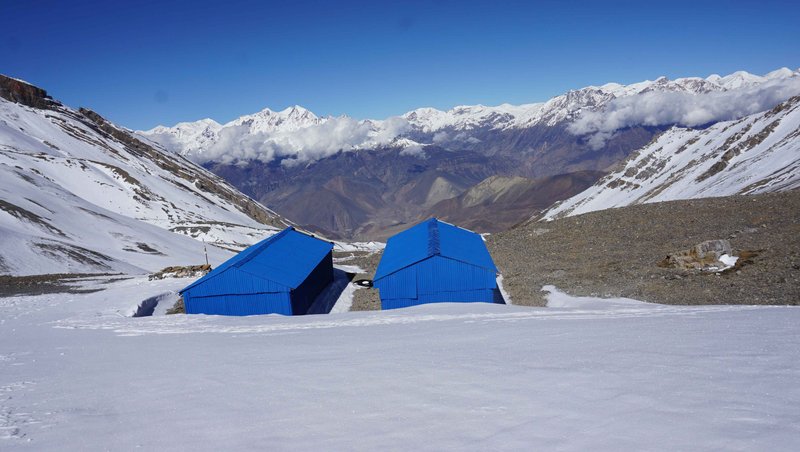
Conquering Thorong La Pass (5,416 m)
Crossing the Thorong La Pass trek, which is one of the highest passes in Nepal, is an ultimate test of your fitness and endurance level. As you start your journey to reach the flag-adorned summit, your thrill and excitement increase with the panoramic vistas and crisp air around you. And after reaching the summit, when you stand there, the flags will give you the feeling of a sacred connection with the mountains. As your heart feels the serenity and exhilaration, you need to prepare yourself for the immediate descent as well.
Therefore, you should start your trek early in the morning as it is crucial to make a safe and enjoyable crossing in such Annapurna Circuit shorter duration. You need to wear all the appropriate three layers to protect yourself from the cold, wind, and potentially rain. You should take enough snacks and hydrating supplements to keep your energy intact.
Muktinath: A Sacred Sanctuary
Muktinath is one of the key highlights of Nepal’s Best short treks, done in the Annapurna Circuit shorter duration. This temple is one of the sacred places that is immensely popular among Hindus. But also, this temple showcases the religious tolerance and spiritual harmony within the devotees of two largely followed religions: Hinduism and Buddhism.
When you reach Muktinath, you can have the opportunity to get purified with the 108 waterspouts, believed to be a purifier, which means freeing you from any sin that you have committed if your body gets under the water of these spouts, believed to purify your soul. There is an eternal flame that burns perpetually in a cave near the temple. You will descend from the high altitudes to the arid land resonating with the atmosphere of spirituality created by chants and prayers, feeling the connection with the divine. So, you will feel more excitement if you are spiritually inclined.
Lower Mustang & Jomsom
You will find an arid landscape in Jomsom, which is the lower region of Mustang. This part of the lower Mustang has mostly bare mountains and steep canyons with dramatic rock formations. The landscape is unique because you can find deep red and brown coloured light sandy hues, giving the earthy tones. But the mystical charm of Jomsom is the relentless wind, especially in the afternoon, and this defines the lower Mustang.
Josom is home to apple orchards. If you trek in Spring, you can see the apples blooming, which turn to delicious fruits by Autumn. This barren land with the apple orchard shows a diverse ecological region. These scenarios within the Annapurna Circuit shorter duration, make your trek more enjoyable.
Tatopani Hot Springs
If you choose a 10-day short Annapurna Circuit, then you can get to visit this wonder of nature, which is called Tatopani. Tatopani means hot water in English, and this place is a perfect spot for relaxation after exertion. This place has natural hot water, which is in the form of a spring, and the hot water is believed to have healing properties. People come here to have the therapy of soothing and relieving the weary feet and tired muscles. But also, you can engage in conversations and enjoy your time here by enhancing your communal aspect, making the Annapurna Circuit one of Nepal’s best short treks.
The Final Descent to Pokhara
Your Mini Annapurna trek takes its journey towards the final destination, which is Pokhara, if you choose the 6-day short Annapurna Circuit Trek or the 8-day short Annapurna Circuit Trek. This journey will begin from Muktinath, and you will trek from the lush valleys to the rocky terrains and the terraced agriculture. You can see the charming villages of Jomsom and Kagbeni along the Kali Gandaki River. And you will finally reach the lakeside of Pokhara, which is called the Lakeside itself. You will feel the serenity of the Phewa Lake mirroring the surroundings with the views of Mt. Machhapuchhre and the Annapurna range. Also, you will get a vibrant atmosphere to enjoy because of the numerous shops, cafes, and restaurants in Lakeside.
Conquering the Altitude: Acclimatization & Safety on a Condensed Trek
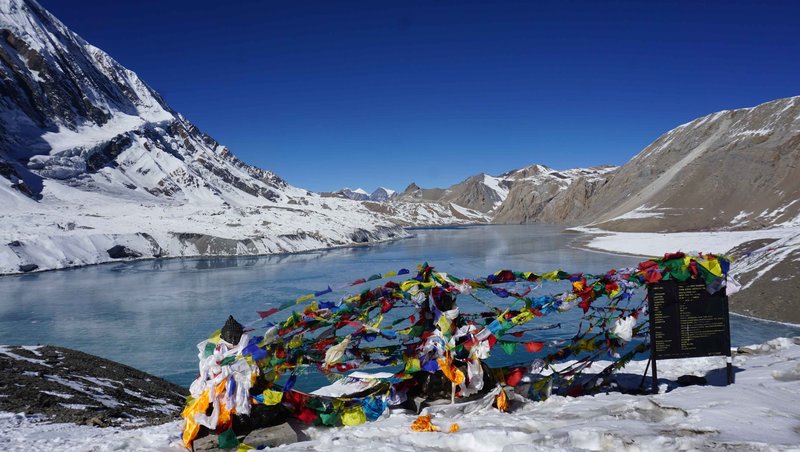
Understanding Acute Mountain Sickness (AMS)
As the altitude increases, the oxygen levels decrease too. When you reach above 2,500 metres, you are more likely to get altitude sickness, which starts from the first level of it called Acute Mountain Sickness (AMS), which is normal. This is crucial that you know about the symptoms as you trek within the Annapurna Circuit shorter duration. If you get AMS, you will get nausea, fatigue, dizziness, and a headache. So, when these symptoms worsen, if untreated, they turn into High Altitude Cerebral Edema (HACE) and High Altitude Pulmonary Edema (HAPE), which are life-threatening conditions. So, it is best if you prevent AMS, and to do this, you need to opt for slow ascent as your body needs time to adjust to the rapid change in altitudes. Also, hydrating yourself is important as you lose minerals through excessive sweating, which makes you more prone to AMS.
Crucial Acclimatization Strategies for Short Treks
The short Annapurna Circuit Trek is still a high-altitude trek, so acclimatization is necessary. One of the acclimatization strategies you need to follow is “Climb High, Sleep Low," which means you need to do high ascent during the daytime and return to sleep at a lower altitude at night. This will help your body adjust to the decreased oxygen level and overcome the Annapurna trekking challenges.
You can do an acclimatization trip to the Ice Lake from Manang, going for short hikes around Chame or strolling around the Braga village to keep your physical limits in check. Even if it is a Mini Annapurna trek, you need to have enough rest to keep you prepared for the daunting trek, especially if you are choosing the 6-day short Annapurna Circuit Trek and the 8-Day short Annapurna Circuit Trek, as these condensed itinerary plans of Annapurna Circuit shorter duration and have fewer acclimatization days.
Hydration & Nutrition
Hydration and nutrition are crucial to tackle the Annapurna trek challenges and to keep going on the exhausting trek. You should drink at least 2 to 3 litres of water, and you can use electrolytes or electrolyte supplements to replenish your minerals lost through sweating. Additionally, taking a balanced, rich diet to get energy throughout the trek and not falling sick due to a poor diet is important. You should focus on eating carbohydrate-rich foods such as rice, for which it is best that you stick to the staple Dal Bhat, which will keep you full and give you nutrition, and is not expensive in comparison with other food choices. You should be eating more vegetables than meat, as they are healthier options. Mostly, we recommend that you not consume any caffeine, alcohol, or meat to avoid any health hazards for the Annapurna Circuit shorter duration.
Medication
We advise you to take the medication for altitude sickness for the Mini Annapurna trek. Diamox (Acetazolamide) is one of the common and popular medicines for preventing altitude sickness. You can take Diamox at least 24 to 48 hours before you embark on your trek. You can take 125 to 250 mg twice daily for the Annapurna Circuit shorter duration, which is considered the typical dosage of this medicine, but we advise you to consult with a health professional. Although you should look out for the side effects if you feel a tingling sensation in your fingers and toes, or if you get a frequent urge to urinate.
Listen to Your Body
Recognizing the signs on your body is crucial for a safe Mini Annapurna trek. If you feel shortness of breath, tiredness, and then the headache persists for a longer time, making you feel dizzy and nauseous too, you must know that it may be AMS. For which you should descend to not let the AMS get worse. You must also check your appetite. But if you start coughing severely and feel confused, then you need immediate medical assistance, and most importantly, go to the lower altitudes to let your body recover.
Travel Insurance
You can get into accidents and injuries, which are common in such high-altitude trekking in Nepal. So, if you have unfortunately got into a fatal or serious accident and have got serious injuries, then you need to have security regarding the rescue service, medical treatment, and saving costs to some extent. So, it is non-negotiable that you will need travel insurance that will cover your medical treatment costs, rescue services, including the helicopter evacuation.
Essential Preparation
Physical Training
The short Annapurna Circuit Trek is very challenging due to the diverse altitudes with the steep ascents and rugged terrains, which demand your fitness. So, you need to prepare yourself for the Annapurna trekking challenges with the physical training sessions 6 to 8 weeks before the trek, focusing on cardiovascular strength, leg, core, and muscle strength.
Cardio: You will be walking multiple days on various altitudes with steep ascent and descent, for which you need to prepare yourself to keep your stamina, heart health, and lung capacity in check. You can do different cardio exercises such as running, cycling, and swimming (mention durations/frequency) for Nepal’s best short treks.
Strength: You need to have a lot of strength to do the Mini Annapurna trek. You will need to have strength in your legs and your core, including muscle strength. If you have a strong core and legs, you can trek quite smoothly as a strong core will enhance your stability and balance, whereas leg strength will allow you to walk for long durations. You can do jump squats, plank with a leg raise, lunges, and setups.
Hiking Practice: You will be carrying a heavy backpack during the short Annapurna Circuit Trek, so you can go for short hikes to be familiar with the rugged terrain and altitude, carrying a weighted backpack to train yourself physically. With the weighted backpack, varied terrain. You should initially train yourself with 5 5-kilometer distance and gradually increase the distance, intensity, and the weight of your backpack. You should practice uphill and downhill sections.
Mental Preparation
You need to have resilience for Annapurna trekking challenges, as the trails will test your endurance and mental state in the harsh conditions of the weather and terrain. If you have positive mental fortitude, you can deal with the stress caused by the obstacles on the Mini Annapurna trek. You need to be flexible, as unexpected physical challenges may arise, and you need to adapt to the changes in your itinerary. Most importantly, always keep realistic expectations and be joyful for your small accomplishments during Nepal’s best short treks.
Packing List
Layers: You need to wear appropriate clothes following the three layers of clothing. Base layers are the first layers of clothing that help to keep moisture away from your body. So, you need to wear these layers made of merino wool or synthetic fabrics that manage your sweat excellently. You need to find something that is breathable, too.
Mid-layers are the insulating layers to keep your body warm. You can wear fleece jackets or down jackets, which trap warmth inside your body. You can also remove them according to the temperatures and comfort.
Outer layers are for the protection against wind, rain, and snow. So, you need to wear clothes that are waterproof and windproof. These layers will keep you dry, so look for the ventilation zippers for air flow as well.
Footwear: You need to wear the right footwear for such strenuous walks. You need to wear broken-in hiking boots that are waterproof and have good sole grip, providing you with good ankle support for the rocky and steep ascent. Additionally, wear them during short hikes to make them mold to your feet to prevent blisters and give you more comfort during high-altitude trekking in Nepal.
On the other hand, you can pack lightweight, comfortable camp shoes and provide you with relief after a long day trekking. They allow your feet to breathe, and are good for slippery ground as well. You can pack sandals or slippers as well to wear at the tea houses and while strolling around the areas.
Gear: You need to pack lightweight gear of good quality for high-altitude trekking in Nepal. You can either rent them or purchase them in Kathmandu and Pokhara.
Trekking poles: You need to take trekking poles for balance and stability on the uneven ground and steep ascents. They will also aid in reducing strain on your knees.
Headlamp: You may start your trek early in the morning or even trek during late evening, for which a high-quality headlamp is necessary. So, look for the ones with a long battery life. The headlamp not only provides you with light during the dark but also allows you to have free movement while navigating the trails.
Water purification: Hydration is crucial, but drinking polluted water will cause serious health hazards. When you trek along the trails, you may drink from the streams, which are not clean, so take water purification tablets or portable water filters to remove harmful bacteria and ensure you are drinking safe water.
Personal First Aid Kit: A First aid kit should have your things, such as medications for altitude sickness, such as Diamox (Acetazolamide). Blisters are common during the long stretches because of the moisture, so keep antiseptic bandages or creams for treating your blisters. You can also take other medications for cough, cold, headache, and stomach issues.
Also cheout thesafesty tips about Annapurna Circuit trek.
Documents & Permits
Since the Annapurna region has strict rules, you will need to get two permits, which you can get from the Nepal Tourism Board in Kathmandu or Pokhara. For the issue, you will need your passport and some passport-size photos. As for a tourist visa, you can get it at the Tribhuvan International Airport in Kathmandu.
Annapurna Conservation Area Permit (ACAP): 30 USD
Trekkers’ Information Management System (TIMS) card: 10 USD
Beyond the Trail: Cultural Immersion & Responsible Trekking
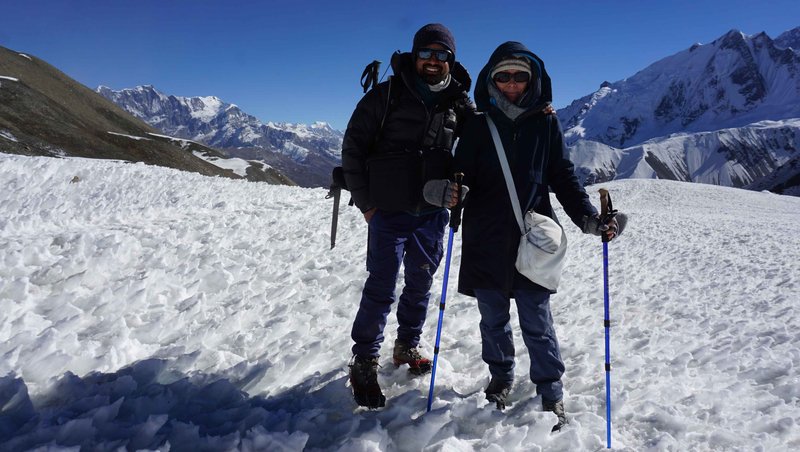
Local Interactions
During Nepal’s best short treks, you can engage in local interactions with the people of Gurungs, Manangis, and Thakalis. While Gurungs are known for their hospitality and histories of bravery, you can learn their customs and have a taste of their local cuisine in their villages, such as Ghandruk and Landruk. As you move to the higher region, Manangis will showcase to you their distinct culture and traditions, mainly influenced by Tibetan culture. If you are lucky enough, you may get to be a part of their Mani Rimdu festival. Similarly, you can savour the local dishes like momo and thukpa of the Thakali people, who are known for their culinary skills. This is part of the cultural trek Annapurna, which will enrich your trekking experience significantly within the Annapurna Circuit shorter duration.
Monasteries & Temples
As part of the cultural trek Annapurna, you can visit the largest monastery of Manang, Barge monastery, which shows the religious and spiritual faith of the locals. This monastery is an important part of Tibetan Buddhism. But as Annapurna region tips, you should be respectful towards the monks and to the holy place by removing shoes before entering and dressing modestly.
On the other hand, the Muktinath temple is popular among the Hindus and Buddhists. So, if you have a plan of doing either the 8-Day short Annapurna Circuit or the 10-Day short Annapurna Circuit Trek, then you can get an insightful experience of the blend of two biggest religions, where you can witness the spiritual water purification featuring 108 waterspouts.
Food
You can not miss out on trying local cuisine during the Mini Annapurna trek. You should eat the famous Thakali cuisine, and you should have the sel roti, momo, thukpa, Tibetan bread, etc. You can also enjoy the staple Dal Bhat with Gundruk, which is a famous dried vegetable in Nepal. This is also part of the cultural trek to Annapurna. Dhindo is also a unique food of Nepal, which you can find during your trek. You should get the taste of apple pies in Marph, including the dried apples.
Responsible Tourism
You must do Nepal’s best short treks, being responsible towards the people and the environment, particularly not affecting the tourism industry. For this, you should follow “Leave No Trace principles” not only by properly disposing of your waste and respecting the wildlife, but also by not taking anything from the area to not ruin the experience of future trekkers. Also, one of the Annapurna region tips is that you can support the local economy by supporting local businesses, such as eating at local eateries, hiring guides and porters, buying handicrafts, which will help in running their livelihood, but also encourage them. Most importantly, please minimize your plastic waste, and it is best if you use biodegradable toiletries and reusable things such as reusable water bottles so as not to affect the environment of the Annapurna region.
Best Time to Trek & Cost Considerations
Seasons
Autumn (Sept-Nov): We highly recommend you to trek during this season as the skies are clear and you will find moderate temperatures. But as this season is the most favored, you can meet a lot of trekkers on the trails, and finding accommodation is difficult, let alone finding one with good facilities.
Spring (Mar-May): Spring is also one of the optimal seasons for Nepal’s best short treks. As the weather is stable and it is the blooming season, you can see the beautiful rhododendrons blooming along the trails, giving you vibrant natural beauty. But one thing that you need to consider is the haze that you may find on some level, which can obstruct the stunning views of the peaks.
Avoid Monsoon & Winter: We advise you not to trek during Monsoon and Winter as these seasons will have more Annapurna trekking challenges, such as challenging trails due to maximum rainfall in monsoon, leading to slippery and muddy trails, increasing your risk of falling and getting injured. Also, the insects get more active because of the moisture, and especially, the landslide is highly probable. While in winter, the temperatures are colder and freezing in the high altitudes and including the accumulation of snow and ice, making the trails slippery. So, one of the Annapurna region tips is that you avoid these two seasons while trekking the Annapurna Circuit shorter duration. You can also check our detailed blog on the best time to trek the Annapurna Circuit trek.
Cost Breakdown
Permits: 33 USD
Guide/Porter fees: 225 USD to 450 USD
Accommodation (teahouses): 150 USD to 450 USD
Food & Drinks: 250 USD to 270 USD
Transportation: 100 USD to 120 USD (flight cost) per person
90 USD to 135 USD (private car or jeep)
6 USD to 12 USD (tourist bus)
Gear (Rental/Purchase): 50 USD to 200 USD
Travel Insurance: 30 USD to 10 USD
Miscellaneous: 50 USD to 100 USD
6-day short Annapurna Circuit Trek: around 600 USD per person
8-day short Annapurna Circuit Trek: around 800 USD per person
10-day short Annapurna Circuit Trek: around 950 USD per person
The average cost of a short Annapurna Circuit Trek will be around 900 USD per person, depending on your itinerary and services. The package costs per person may be slightly more than the group size of trekkers. The trekking agency provides discounts on the cost depending on the group size. All the services, such as accommodation, permits, transportation, food and drinks, guides, and porters, are included in the package.dsd
Planning Your Adventure
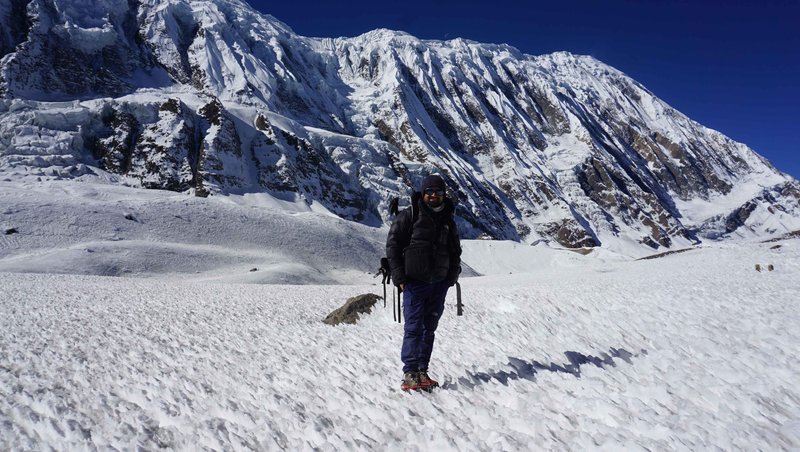
Independent vs. Guided Trek
When you trek independently, one of the good things you can gain out of it is that you will have a more personalized trekking experience because you have control over your itinerary plan and your pace. There is more flexibility as you get to choose your schedule and route, but also the locations that you will be choosing to explore. However, there are some disadvantages of independent trekking in such high altitude trekking Nepal as guided trekking will be more insightful as guides can provide you local insights with their local knowledge and help you build a good connection with the locals along the trails and especially at the tea houses and during the ceremonies that you attend.
On the other hand, guided trekking in high-altitude trekking in Nepal is more secure than independent trekking, as the guides are trained in providing first aid and dealing with unexpected scenarios where your life is at stake. So, medical facilities may reach you faster if you are with a licensed guide during the Annapurna Circuit shorter duration. However, a guided trek will be more costly than an unguided trek, which needs to be considered if you are a budget-conscious trekker.
Choosing a Reputable Company
When you plan, you need to choose a reputable trekking company that has a license and is registered with the Trekking Agencies’ Association of Nepal (TAAN). The license will provide you with confirmation that they are not fraudulent and ensure that they operate within the regulations of high-altitude trekking in Nepal. Additionally, you need to see their safety records, including their emergency response plans, to see if they are committed to safety protocols, for which you can also check their previous trekkers’ reviews and testimonials. Furthermore, you need to choose a trekking agency that abides by ethical tourism practices, such as paying fair wages to their staff and committing to environmental sustainability.
Booking in Advance vs. On Arrival
If you are booking high-altitude trekking in Nepal in advance, you will have advantages, such as have high chance of getting a reliable trekking agency that provides you with experienced guides, and also good accommodation, when the lodges may get packed if you arrive during peak seasons. Additionally, you will have an itinerary plan of Annapurna Circuit shorter duration according to your fitness level and time preferences, making it a smooth experience for you.
On the other hand, booking on arrival will let you plan your Mini Annapurna trek according to the present weather conditions and health considerations. This approach may get you some discounts if you are there during the off-peak season. However, you may not get good accommodation and experienced guides. Therefore, we advise you to book the Annapurna Circuit shorter duration in advance for a hassle-free trekking experience.
Flexibility: Why it's key
You need to be flexible while planning your Mini Annapurna trek, as the weather is unpredictable in the Himalayas. If you have a flexible itinerary, you can choose a safe route and adjust the itinerary based on the weather conditions. Additionally, if you fall sick or altitude sickness arises, you can get to take rest. Furthermore, a flexible itinerary will provide you with the opportunity to engage in the local ceremonies and gain local knowledge of their unique local lifestyle. So, you can make spontaneous stops at the villages and gain enriching cultural encounters in your leisure time.
Conclusion: Your Unforgettable Short Annapurna Circuit Awaits
The short Annapurna Circuit Trek makes it accessible for all the people who want to experience the adventure and beauty of the Annapurna region within a limited time frame. You can sense the natural grandeur in every step with the resilience in you. You can explore the cultural tapestry of the locals and the serene natural viewpoints during a short period. From the lush forests to the high hills and from the religious and spiritual Muktinath to the relaxing Tatopani, you will make unforgettable memories in this Mini Annapurna trek. Without giving long days, just perfectly fitting into your time preferences and fitness levels, these Nepal’s Best short treks will give you stories to share.
Please feel free to contact us at [email protected] or WhatsApp us at +9779801127073.
annapurna-circuit-trek-14-days

